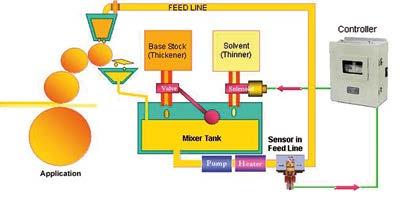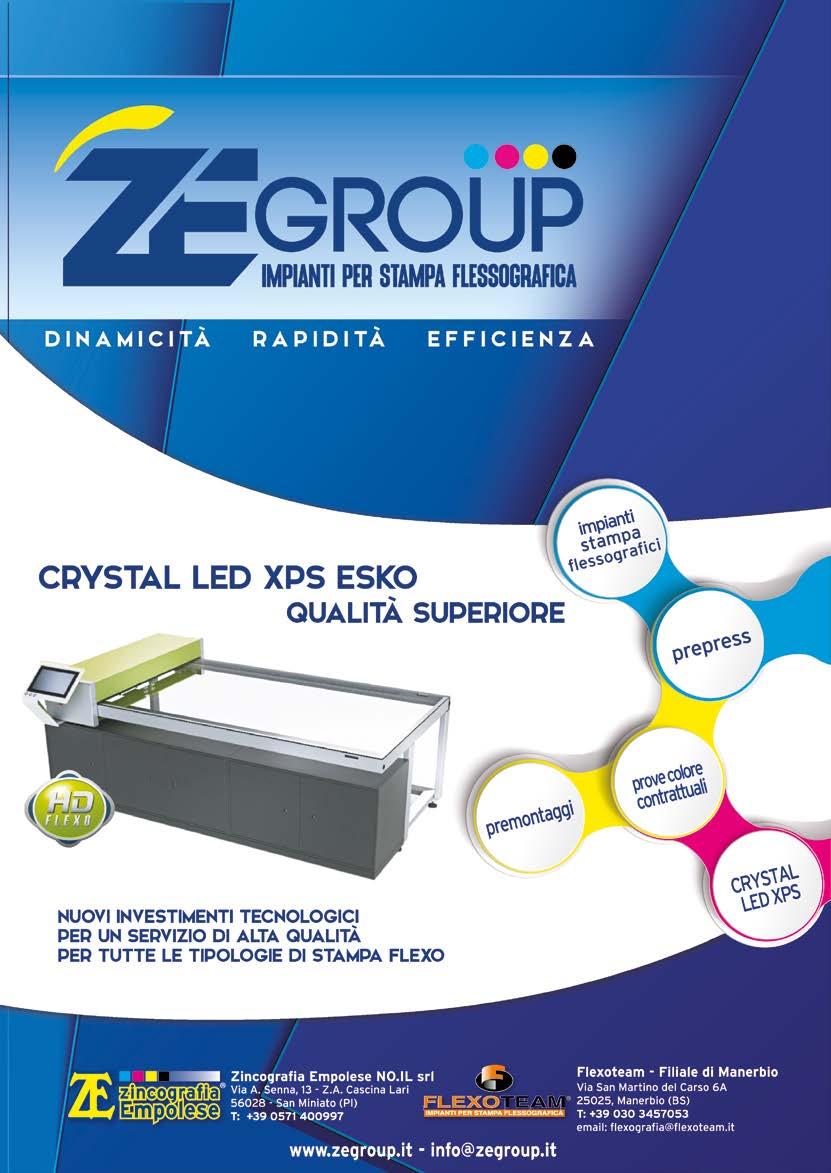
10 minute read
A solid and precise tool to control viscosisty even for most difficult applications
La corretta gestione del processo di verniciatura, che garantisce gli spessori desiderati, implica il controllo e l’eventuale correzione dei parametri operativi e delle materie prime, con particolare attenzione a quelle ad alto contenuto di solidi fatte ricircolare. La verifica della viscosità consente il controllo delle materie prime e la compensazione dell’effetto della temperatura su di esse. Dal momento che il controllo completo della temperatura dell’impianto spesso non è fattibile, la compensazione termica della viscosità (TCV) fornisce un modo efficace per regolare queste variazioni dovute al cambiamento della temperatura. Il raggiungimento e il mantenimento della viscosità ottimale è pertanto sinonimo di efficacia ed efficienza dell’impianto.
ENGLISH Version
Advertisement
OPZIONI PER MISURARE LA VISCOSITÀ
Ogni vernice ha una caratteristica curva temperatura-viscosità. Se la temperatura di esercizio e la viscosità della vernice sono note, la TCV consente all’operatore di stabilire facilmente se la percentuale di sostanze solide è corretta, alta o bassa indicando anche quali correzioni siano necessarie. Per questo motivo, un metodo di misura che includa direttamente la TCV è spesso preferito. Tra i diversi metodi utilizzati per misurare la viscosità delle vernici, il metodo a “tazza di deflusso” è quello più tradizionale. Gli svantaggi di questo metodo sono la scarsa consistenza e la bassa ripetibilità. Al contrario, la

A solid and precise tool to control viscosity even for most difficult applications
VISCOPRO 2100 BY CAMBRIDGE VISCOSITY, A USA BASED COMPANY MANUFACTURER OF LAB AND PROCESS ANALYZERS, AND DISTRIBUTED BY SRA INSTRUMENTS, IS A LAST GENERATION VISCOMETER WITH EXCLUSIVE FEATURES
VISCOpro has very precise, reliable and self-cleaning sensors that ensure product quality, image clarity and good resolution, correct and uniform film thickness and optimization of processing speeds, assuring smooth coating and printing processes, reducing wastes and improving production of inks, varnishes, glues and coatings. For very complex fluids the correct viscosity is a fundamental requirement to provide a constant quality of the final product, maintain the equipment and optimize the use of materials. The advanced inline or immersion sampling sensors of VISCOpro 2100 are available in a variety of sizes for installation in any production environment. The tool is distributed by SRA Instruments, directly present in Italy and France, that operates in the field of research, development and customization of analytical solutions dedicated to environmental, food, petrochemical and energy areas. SRA is one of the most important European Premier Solution Partner of Agilent Technologies on whose instrumentation GC, GC-MS, LC, LC-MS and FT-IR the company builds its own solutions.
COATING VISCOSITY CONTROL GIVES HUGE BENEFITS FOR Even though raw coating materials are perfect when they enter a converter’s plant, they usually don’t stay that way for long and deteriorate during use. Tipically the failure mechanism is simple. As a thin layer of coating material is deposited on a roller drum for coating, it is exposed to air often at elevated temperatures. This is ideal for evaporation to occur. Then the coating is squeezed against other rollers and ultimately against the targeted material itself, which further concentrates the solids in the material on the rollers. High-solids material is then recirculated in the applicator pan and day tank. To control the coating process and consistently achieve the targeted coat weight, the residual recirculated coating material high in solids must be refreshed. Viscosity control allows this refreshment to be managed effectively, but proper viscosity control requires compensation for temperature effects. This is due to the significant impact that temperature has on viscosity and the fact that temperature changes are common in many coating operations. Because full control of plant temperatures is frequently not feasible, temperature-compensated viscosity (TCV) provides an effective way to adjust for variations in process temperatures.
OPTIONS FOR MEASURING VISCOSITY Each coating has a characteristic temperature-viscosity curve. If the running temperature and coating viscosity are known, TCV allows the converter to easily know whether solids are high, low or just right. TCV also indicates what corrections are needed. For this reason, many converters are choosing a method that directly incorporates TCV. Of the various methods for measuring coatings, the cup method is the traditional way to monitor viscosity. The drawbacks of the cup method are
misurazione assoluta della viscosità della vernice, misurata in centipoise, è migliore perché più precisa.
IL NUOVO VISCOSIMETRO A PISTONE VISCOPRO 2100: LE OPZIONI DEI SENSORI
Un metodo innovativo per misurare la viscosità delle vernici vede l’applicazione del viscosimetro brevettato a pistone, che combina precisione e ripetibilità a semplicità ed economicità di esercizio, garantendo manutenzioni ordinarie minime o nulle. VISCOpro 2100 di Cambridge Viscosity è progettato per resistere alle sfide dell’industria manufatturiera: con un sensore resistente, questo viscosimetro è quasi insensibile agli effetti dell’ambiente esterno come flussi d’aria o vibrazioni. Il movimento continuo del pistone è garanzia di autopulizia e può funzionare per anni senza ricalibrazione. Ogni viscosimetro di Cambridge Viscosity utilizza una tecnologia proprietaria dei sensori, che hanno solo una parte mobile, il pistone, azionato elettro-magneticamente in una piccola camera di misura in cui è presente il fluido. Un deflettore, posizionato sopra il pistone, sposta il fluido nella camera di misura, mentre due bobine muovono il pistone avanti e indietro con una forza costante. Il circuito, proprietario, analizza il tempo di percorrenza bidirezionale per misurare la viscosità assoluta, rendendo il viscosimetro molto efficace. Inoltre, poiché tutte le parti a contatto con il fluido sono in acciaio inossidabile e il pistone è in costante movimento, l’area di campionamento è resistente all’usura ed è continuamente pulita.

MISURAZIONE DEL ROI
Ogni processo produttivo è diverso, ma quasi tutti hanno evidenziato perdite causate dall’evaporazione durante la fase di verniciatura che possono arrivare a circa 4.5 l di fluido per 9.290 mq di materiale rivestito. Controllare la viscosità con il viscosimetro a pistone consente di compensare automaticamente la perdita addizionando un solvente o acqua. Operazione più economica, data la differenza di costo tra il solvente e le vernici di base. I vantaggi possono essere davvero significativi. Gli utilizzatori, infatti, segnalano un risparmio di materiale da 2 a 12 volte nel primo anno, a seconda delle
poor consistency and repeatability. A far better measurement is the coating’s absolute viscosity, measured in centipoise and more precise.
NEW DRIVEN-PISTON VISCOMETER VISCOPRO 2100: SENSOR OPTIONS A proprietary, driven-piston viscometer is a new method for measuring in process coating viscosity. It combines accuracy and repeatability with reportedly little to no maintenance required. Cambridge Viscosity’s VISCOpro 2100 is designed to stand up to the challenges within the process industry. With a sensor that is designed to protect itself from outside elements, VISCOpro 2100 is highly insensitive to the outside environment. Its continuous piston motion means that the VP2100 is self-cleaning and can run for years without recalibration. Every Cambridge Viscosity viscometer uses one proprietary sensors technology. Sensors have only one moving part, a piston, driven electromagnetically through fluid in a small measurement chamber. A deflector, positioned over the piston, moves fluid into the measurement chamber, while two coils move the piston back and forth at a constant force. Proprietary circuitry analyzes its two-way travel time to measure absolute viscosity. This translates into a highly effective viscometer. Further, because all wetted parts are stainless steel and the piston is in constant motion, the sampling area is continually scrubbed clean.
GAUGING ROI Every operation is different, but many converters find that evaporation losses in coating operations can total roughly a gallon of fluid per 100,000 sq ft of material coated. Controlling the viscosity with the driven-piston viscometer allows the loss to be made up automatically with inexpensive solvent, rather than being replaced with more expensive base coating. Benefits can be impressive. Users report paybacks from material savings of 2 to 12 times in the first year, depending on their operating characteristics. In addition, it is not unusual for converters to report coating consistencies in the range of 0.1 lb of coating per roll of finished product. Improved coating consistency, quality and cost savings can all be achieved with inline coating viscosity control with driven-piston VISCOpro system.


caratteristiche dell’impianto. Inoltre, non è insolito che gli addetti riferiscano una maggiore uniformità della verniciatura nell’ordine di 45 g di vernice per rotolo di prodotto finito. Migliore uniformità, qualità e risparmio sui costi possono essere ottenuti semplicemente con il controllo della viscosità in linea con il sistema a pistone VISCOpro.
Viscosità sotto controllo significa verniciatura perfetta
Descriviamo il funzionamento del viscosimetro a pistone analizzando un processo di verniciatura (Fig. 1). Nel serbatoio, le vernici fresche vengono miscelate al fluido ricircolato dalla vasca di riciclo e al liquido di riempimento (solvente o acqua). I vari componenti della miscela hanno viscosità differenti. Si potrebbe ipotizzare che le vernici fresche abbiano un livello perfetto di solidi, il fluido ricircolato sia ricco di particelle solide (e spesso di bolle), mentre i liquidi di riempimento siano privi di residui. L’impianto è caricato con materiali dalle caratteristiche radicalmente differenti, che vengono miscelati per ottenere un fluido omogeneo con le caratteristiche necessarie per ottenere un particolare prodotto di verniciatura. Se consideriamo una configurazione tipica degli impianti, il settore ideale per installare il viscosimetro in linea è il punto in cui il materiale miscelato viene pompato nella vaschetta dell’applicatore sul dispositivo di verniciatura. Il viscosimetro VISCOpro trova particolare applicazione grazie alle innovazioni progettuali che lo caratterizzano. Il sensore ha una parte mobile e senza guarnizioni, progettata per essere autopulente e immersa costantemente in un fluido, ed è costruita in acciaio per ovviare all’usura causata dall’umidità e dal movimento. Nello specifico la camera di misura del sensore contiene da 1 a 2 ml del fluido di processo e si compone di un pistone indipendente e due bobine. Le bobine guidano elettro-magneticamente il pistone attraverso il fluido: con cadenza prestabilita una bobina fornisce la forza per muovere il pistone, mentre l’altra misura quanto tempo impiega il pistone a compiere il movimento. Il tempo di percorrenza è la misura diretta della viscosità. Quando il pistone viene spinto verso la base chiusa della camera il materiale scorre intorno al pistone ed esce nel flusso del fluido principale. Quando la direzione del pistone viene invertita, nuovo materiale viene aspirato attorno al pistone. Questa azione di lavaggio pulisce il sensore ad ogni passaggio, anche durante la misurazione. Contemporaneamente il viscosimetro monitora la temperatura. L’elettronica combina le misurazioni di temperatura e viscosità per calcolare e tracciare la compensazione termica della viscosità (TCV). L’unità include un controller integrato, sei impostazioni di allarme, un registratore di dati a 1.000 punti e comunicazioni RS232 complete. Sono disponibili versioni per area sicura e area classificata Ex.
Fig. 1

Viscosity under control means perfect coating
A typical coating operation can be used to describe how the driven-piston viscometer works (Fig. 1). In the day tank, new coating material is blended with fluid recirculated from the coating pan and make-up fluid (solvent or water). Various component of the mix have different viscosities. You could think that fresh coatings have the perfect level of solids, while the recirculated material is high in solids (and often in bubbles), and the make-up fluid probably has no solids. The system accepts materials with radically different characteristics and blends them into a homogeneous material with the characteristics required for a particular coating. If we consider the typical configuration of these plants, The spot where mixed material is pumped out and into the applicator pan on the coater is an ideal place to install the in-line viscometer. VISCOpro has special application thanks to innovations that characterize it. The viscometer sensor has one moving part and no seals, with all wetted parts made of stainless steel. Designed to be fully always wetted, the unit is also self-cleaning. The test chamber typically houses 1 to 2 ml of process fluid and is composed by a freestanding piston and two coils. The coils drive the piston through the fluid electromagnetically. At any given time, one coil provides the force to move the piston, while the other coil measures how long it takes the piston to travel. The travel time is a direct measurement of viscosity. As the piston is driven toward the chamber’s closed base, it pushes the material at the base of the chamber. The material flows around the piston and out into the main fluid flow. When the piston’s direction is reversed, new material is sucked in around the piston. This flushing action cleans the sensor with every stroke, even as the measurement is being taken. At the same time, the temperature is tracked. Electronics combines temperature and viscosity temperature to calculate and track TCV. The unit also includes an integrated controller, six alarm settings, a 1,000- point datalogger, and full RS232 communications. Versions for safe area and Ex classified area are available.











